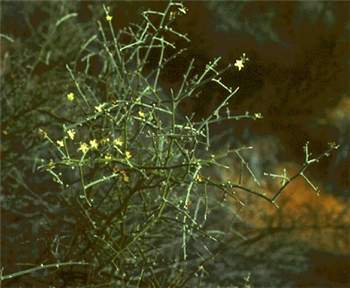Taxonomy
Crenidium Haegi, Telopea 2: 179 (1981); from the Greek krenidion (a spring or fountain), alluding to the exserted stamens and style.
Type species: C. spinescens Haegi.
Shrubs, leafless except young branches. Flowers in cyme-like clusters at nodes, bisexual, slightly zygomorphic, each subtended by a pair of opposite bracts. Calyx cupular, 5–lobed. Corolla narrowly tubular with spreading limb, pale yellow; limb with 5 short, broad lobes, induplicate in bud. Stamens usually 4, didynamous, inserted at base of corolla-tube; a staminode present or rarely fertile; anthers unilocular, not cohering, dehiscing by a semicircular slit. Ovary bilocular; stigma capitate, very shortly bilobed. Fruit a smooth capsule, opening by 2 bifid valves, the lower half enclosed by calyx. Seeds subreniform. n=35; L.Haegi, loc. cit.
A monotypic genus endemic to inland south-western W.A. and the southern eremea.
L. Haegi, A conspectus of Solanaceae tribe Anthocercideae, Telopea 2: 173–180 (1981).
Changes since the Flora of Australia treatment
There have been no changes in the number of species since the Flora of Australia treatment.
Phylogenetic studies by Garcia & Olmstead (2003) on the Tribe Anthocercideae using two chloroplast DNA regions indicated that Cyphanthera and Duboisia are not monophyletic and these genera may need to be recircumscribed in the future. Cyphanthers odgersii showed a closer relationship to Grammosolen while the rest of the Cyphanthera species combined to form a clade with Duboisia and Crenidium.
Reference: V.F.Garcia & R.G.Olmstead (2003). Phylogenetics of Tribe Anthocercideaea (Solanaceae) based on ndhF and trnL/F sequence data. Systematic Botany 28: 609-615.
Key to species
Only a single species, Crenidium spinescens, is endemic to Australia.


